Potential Temporal and Spatial Trends of Oceanographic Conditions with the Bloom of Ulva Prolifera in the West of the Southern Yellow Sea
Abstract
:1. Introduction
2. Data Sources and Methods
2.1. Data Sources
2.2. Methods
3. Results
3.1. Sea Surface Temperature (SST)
3.2. Suspended Sediment Concentration (SSC)
3.3. Wind Field
4. Discussion
4.1. Relationship between the Intensity of U. prolifera and the SST
4.2. Relationship between the Intensity of U. prolifera and the SSC
4.3. Relationship between the Intensity of U. prolifera and the Wind Field
4.4. Human Intervention
5. Conclusions
Author Contributions
Funding
Data Availability Statement
Acknowledgments
Conflicts of Interest
References
- Fan, S.L.; Fu, M.Z.; Li, Y. Origin and development of Huanghai (Yellow) Sea green-tides in 2009 and 2010. Bull. Mar. Sci. 2012, 34, 187–194. [Google Scholar] [CrossRef]
- Liu, D.Y.; Keesing, J.K.; Xing, Q.G.; Shi, P. World’s largest macroalgal bloom caused by expansion of seaweed aquaculture in China. Mar. Pollut. Bull. 2009, 58, 888–895. [Google Scholar] [CrossRef]
- Li, Y.; Song, W.; Xiao, J.; Wang, Z.L.; Fu, M.Z.; Zhu, M.Y.; Li, R.X.; Zhang, X.L.; Wang, X.N. Tempo-spatial distribution and species diversity of green algae micro-propagules in the Yellow Sea during the large-scale green tide development. Harmful Algae 2014, 39, 40–47. [Google Scholar] [CrossRef]
- Keesing, J.K.; Liu, D.; Fearns, P.; Garcia, R. Inter- and intra-annual patterns of Ulva prolifera green tides in the Yellow Sea during 2007–2009, their origin and relationship to the expansion of coastal seaweed aquaculture in China. Mar. Pollut. Bull. 2011, 62, 1169–1182. [Google Scholar] [CrossRef]
- Cui, J.J.; Zhang, J.H.; Huo, Y.Z.; Zhou, L.J.; Wu, Q.; Chen, L.P.; Yu, K.F.; He, P.M. Adaptability of free-floating green tide algae in the Yellow Sea to variable temperature and light intensity. Mar. Pollut. Bull. 2015, 101, 660–666. [Google Scholar] [CrossRef] [PubMed]
- Song, D.B. Temporal-Spatial Distribution and Countermeasures Study of Algae Disaster in the Bohai and Yellow Sea Based on Multi-source Data. Ph.D. Thesis, University of Chinese Academy of Sciences (Yantai Institute of Coastal Zone Research, Chinese Academy of Sciences), Yantai, China, 2019. [Google Scholar]
- Li, H.Y. Ulva prolifera Detection Using Time-series GOCI Images and Analysis on the Key Environment Factors to Its Growth. Master’s Thesis, Nanjing University, Nanjing, China, 2018. [Google Scholar]
- Liu, X.Q.; Wang, Z.L.; Zhang, X.L. A review of the green tides in the Yellow Sea, China. Mar. Environ. Res. 2016, 119, 189–196. [Google Scholar] [CrossRef]
- Zhang, Z.; Chen, Y.L.; Luo, F. Temporal and Spatial Distribution Characteristics of Enteromorpha prolifera in the South Yellow Sea Based on Remote Sensing Data of 2014. J. Huaihai Inst. Technol. 2016, 25, 80–85. [Google Scholar] [CrossRef]
- Xiao, Y.; Zhang, J.; Cui, T. High-precision extraction of nearshore green tides using satellite remote sensing data of the Yellow Sea, China. Int. J. Remote Sens. 2017, 38, 1626–1641. [Google Scholar] [CrossRef]
- Zhang, G.Z.; Wu, M.Q.; Sun, X.; Zhao, D.H.; Xing, Q.G.; Liang, F. The Inter-annual Drift and Driven Force of Ulva Prolifera Bloom in the Southern Yellow Sea. Oceanol. Limnol. Sin. 2018, 49, 1084–1093. [Google Scholar] [CrossRef]
- Sun, X. Spatial and Temporal Variations and Response Mechanism of Green Tide and Chlorophyll a Concentrations Based on Remote Sensing in Southern Yellow Sea. Master’s Thesis, Ludong University, Yantai, China, 2018. [Google Scholar]
- Xu, Q.; Zhang, H.Y.; Ju, L.; Chen, M.X. Interannual variability of Ulva prolifera blooms in the Yellow Sea. Int. J. Remote Sens. 2014, 35, 4099–4113. [Google Scholar] [CrossRef]
- Bai, Y.; Zhao, L.; Liu, J.Z. The role of ecological factors in the progress of the green tide in the Yellow Sea. Haiyang Xuebao 2019, 41, 97–105. [Google Scholar] [CrossRef]
- Zhang, H.B.; Liu, K.; Su, R.G.; Shi, X.Y.; Pei, S.F.; Wang, X.L.; Wang, G.S.; Wang, S. Study on the coupling relationship between the development of Ulva prolifera green tide and nutrients in the southern Yellow Sea in 2018. Haiyang Xuebao 2020, 42, 30–39. [Google Scholar] [CrossRef]
- Manuel, Z.I.V.J.; Darío, C.G.; Marín, P.G.; Arturo, R.T.D.; Gustavo, P.V. Spatial modeling of forest fires in Mexico: An integration of two data sources. Bosque 2017, 3, 563–574. [Google Scholar] [CrossRef]
- Wang, Z.Q.; Lu, Z.Y.; Cui, G.L. Spatiotemporal Variation of Land Surface Temperature and Vegetation in Response to Climate Change Based on NOAA-AVHRR Data over China. Sustainability 2020, 12, 3601. [Google Scholar] [CrossRef]
- Ranzi, R.; Grossi, G.; Bacchi, B. Ten years of monitoring areal snowpack in the Southern Alps using NOAA-AVHRR imagery, ground measurements and hydrological data. Hydrol. Process. 2015, 13, 2079–2095. [Google Scholar] [CrossRef]
- Zheng, C.W.; Jing, P.; Li, J.X. Assessing the China Sea wind energy and wave energy resources from 1988 to 2009. Ocean Eng. 2013, 65, 39–48. [Google Scholar] [CrossRef]
- Zheng, C.W.; Pan, J. Assessment of the global ocean wind energy resource. Renew. Sust. Energ. Rev. 2014, 33, 382–391. [Google Scholar] [CrossRef]
- Oey, L.Y.; Chang, Y.L.; Lin, Y.C.; Chang, M.C.; Varlamov, S.; Miyazawa, Y. Cross Flows in the Taiwan Strait in Winter. J. Phys. Oceanogr. 2014, 44, 801–817. [Google Scholar] [CrossRef]
- Yagi, M.; Kutsuwada, K. Validation of different global data sets for sea surface wind-stress. Int. J. Remote Sens. 2020, 41, 6022–6049. [Google Scholar] [CrossRef]
- Li, M.; Zhang, R.; Hong, M. Marine Disaster Assessment and Management Based on Weighted Bayesian Network. Ocean Dev. Manag. 2018, 35, 52–59. [Google Scholar] [CrossRef]
- Wen, S.Y.; Song, X.; Tian, Y.Y.; Zhang, Q.; Chen, C.; Gao, S.G.; Zhao, D.Z. Technology and Method for Economic Losses Assessment of Red Tide Disasters. J. Catastrophol. 2015, 30, 25–28. [Google Scholar] [CrossRef]
- Xie, X.; Tao, A.F.; Zhang, Y.; Zeng, Y.D.; Zheng, J.H. The Temporal and Spatial Distribution Vcharacteristics of Typical Marine Disasters in Fujian Province. Trans. Oceanol. Limnol. 2018, 4, 21–30. [Google Scholar] [CrossRef]
- Xiong, X.J. China Offshore Ocean—Physical Ocean and Marine Meteorology; China Ocean Press: Beijing, China, 2012. [Google Scholar]
- Duchemin, B. NOAA/AVHRR Bidirectional Reflectance—A method for reducing noise in NDVI time-series. Remote Sens. Environ. 1999, 67, 51–67. [Google Scholar] [CrossRef]
- Hiraoka, M.; Ohno, M.; Kawaguchi, S.; Yoshida, G. Crossing test among floating ulva thalli forming ‘green tide’ in japan. Hydrobiologia 2004, 512, 239–245. [Google Scholar] [CrossRef]
- Iii, J.; Collado-Vides, L.; Lopez-Bautista, J.M. Molecular identification and nutrient analysis of the green tide species ulva ohnoi m. hiraoka & s. shimada, 2004 (ulvophyceae, chlorophyta), a new report and likely nonnative species in the gulf of mexico and atlantic florida, usa. Aquat. Invasions 2016, 11, 225–237. [Google Scholar] [CrossRef]
- Chávez-Sánchez, T.; Piñón-Gimate, A.; Serviere-Zaragoza, E.; Sánchez-González, A.; Hernández-Carmona, G.; Casas-Valdez, M. Recruitment in ulva blooms in relation to temperature, salinity and nutrients in a subtropical bay of the gulf of California. Bot. Mar. 2017, 60, 257–270. [Google Scholar] [CrossRef]
- Wang, J.F.; Si, G.C.; Yu, F. Progress in studies of the characteristics and mechanisms of variations in the Taiwan Warm Current. Mar. Sci. 2020, 44, 141–148. [Google Scholar] [CrossRef]
- Li, G.X.; Qiao, L.L.; Dong, P.; Ma, Y.Y.; Xu, J.S.; Liu, S.D.; Liu, Y.; Li, J.C.; Li, P.; Ding, D. Hydrodynamic condition and suspended sediment diffusion in the Yellow Sea and East China Sea. J. Geophys. Res. Oceans 2016, 121, 6204–6222. [Google Scholar] [CrossRef] [Green Version]
- Chen, S.G. Variations and Influencing Mechanisms in the Optical Properties of the Waters in the Yellow Sea and Bohai Sea. Ph.D. Thesis, Ocean University of China, Qingdao, China, 2015. [Google Scholar]

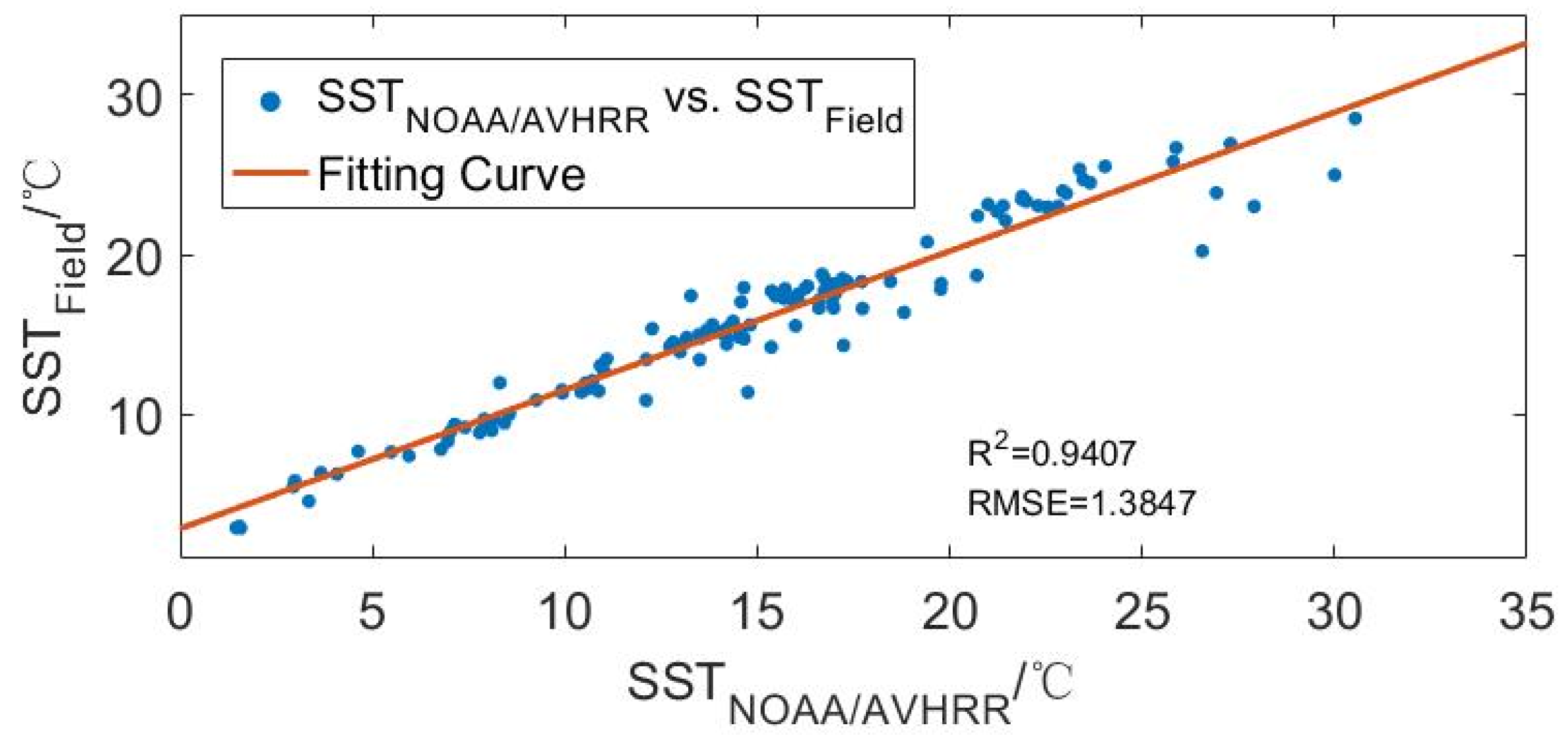



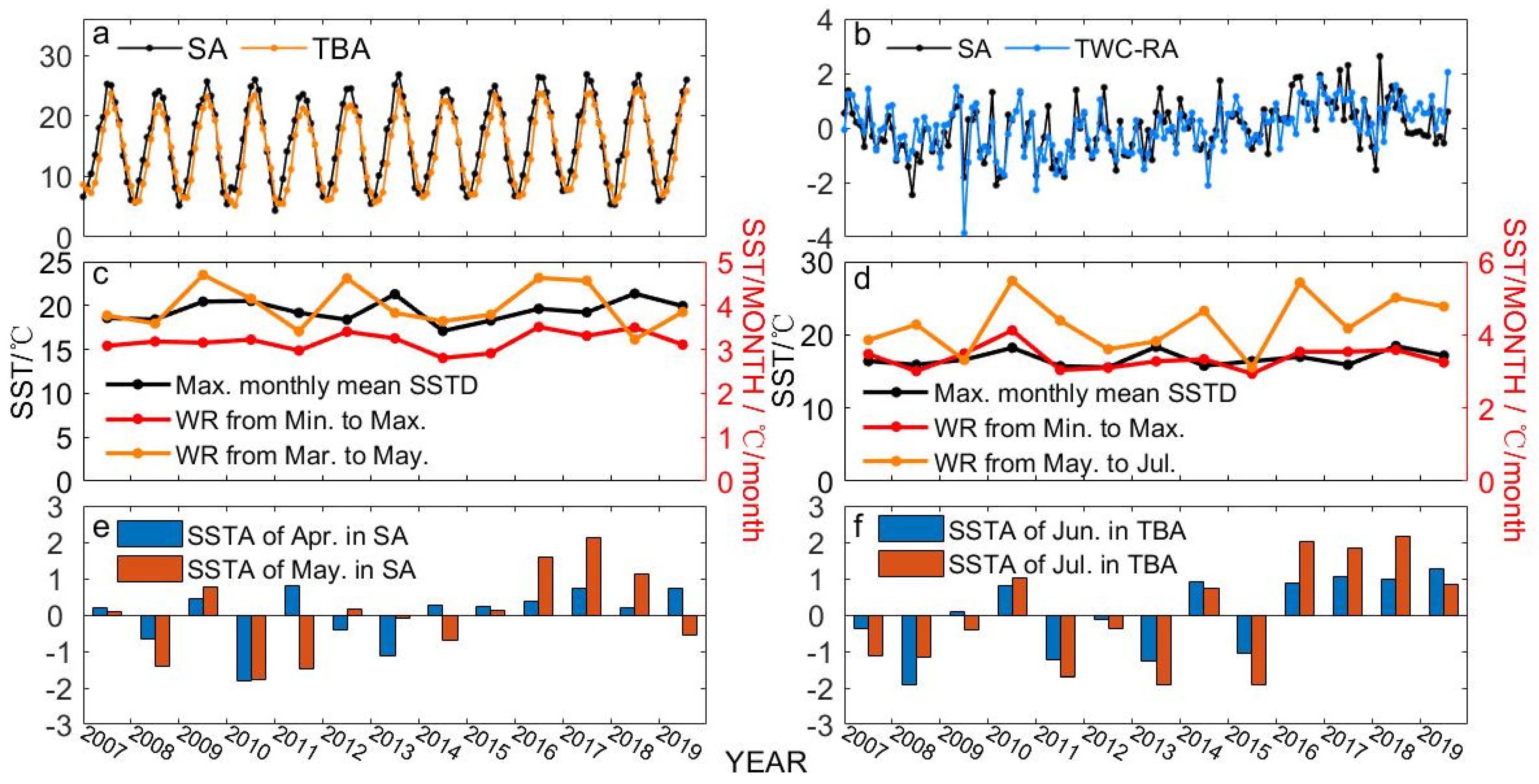


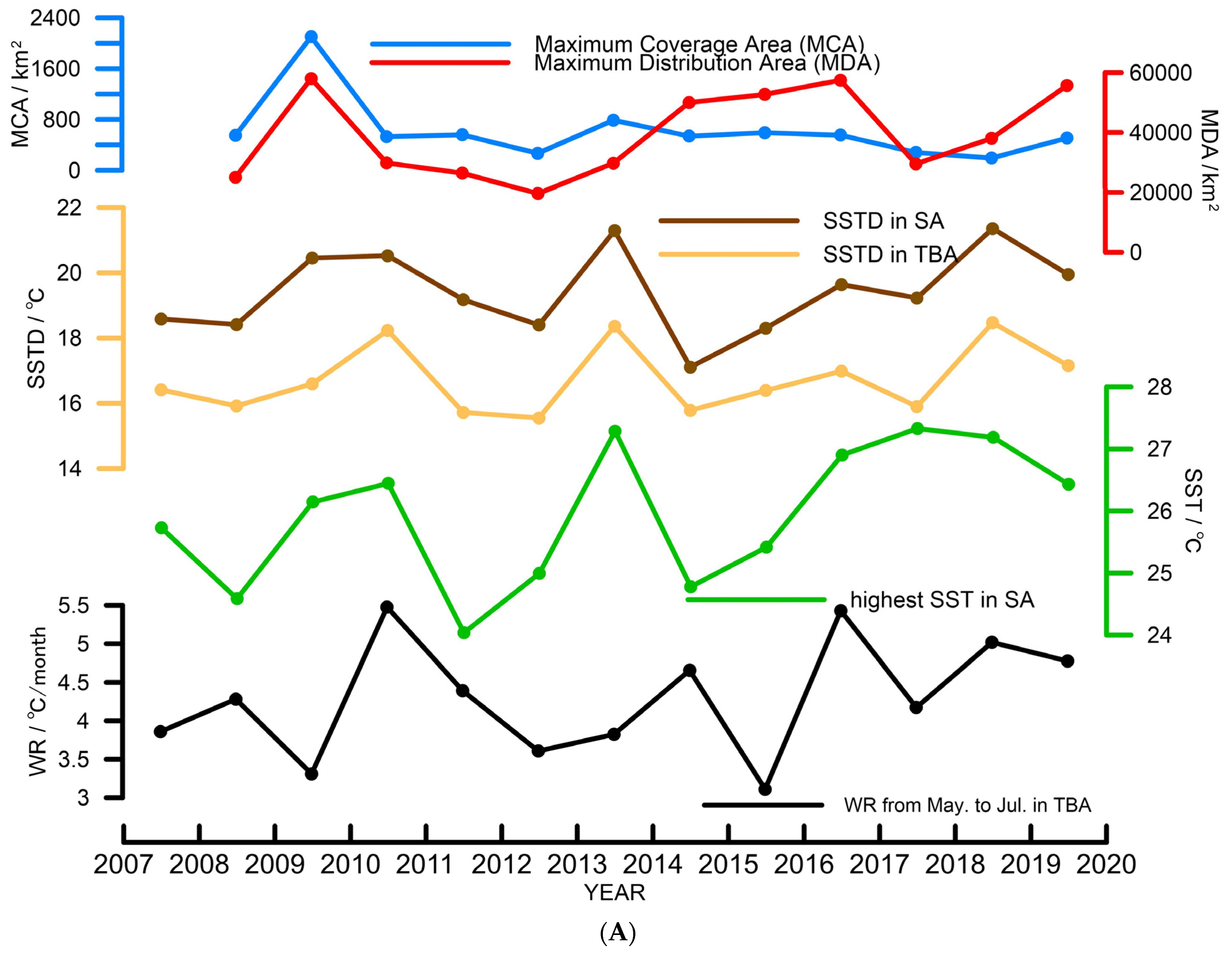
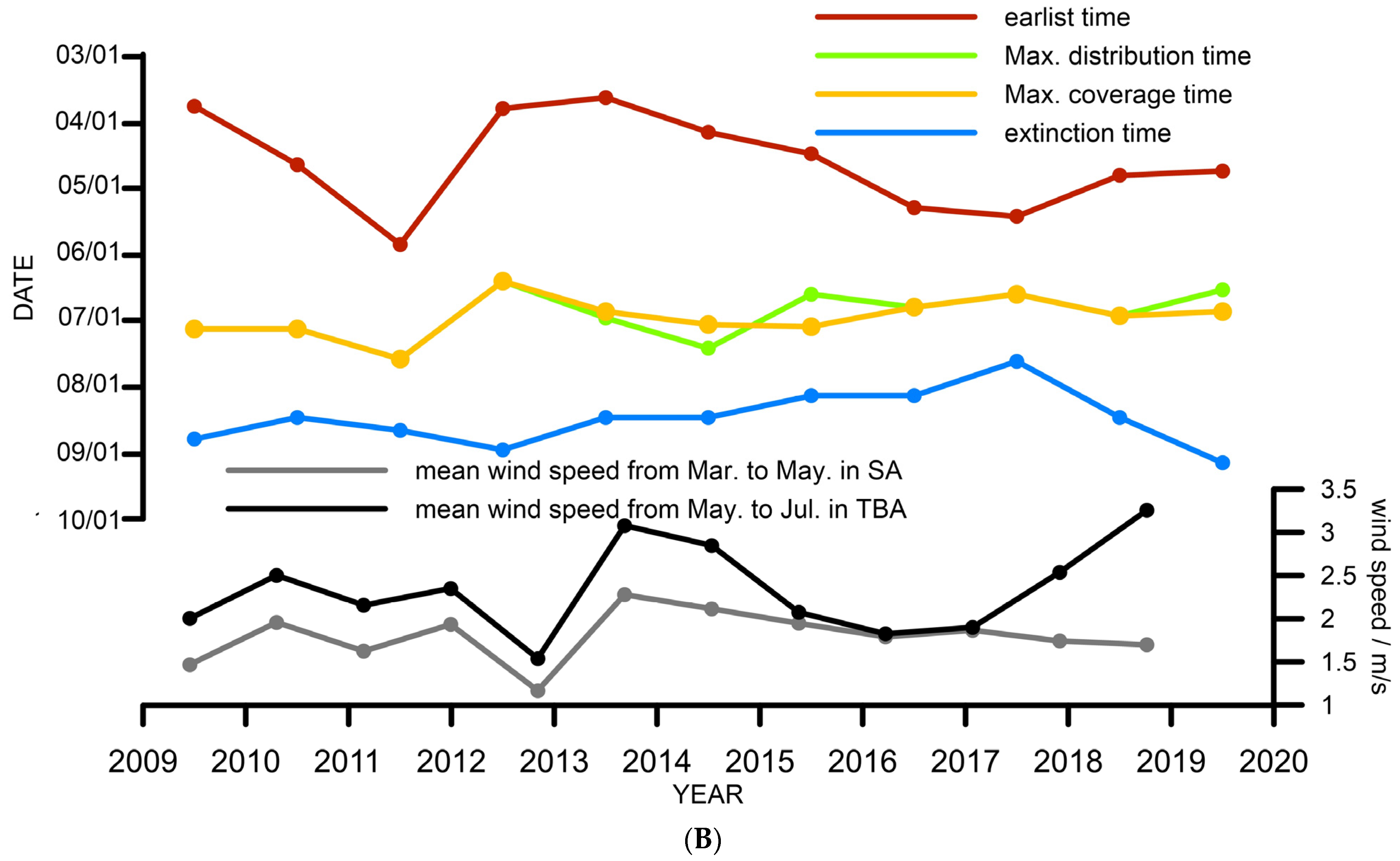
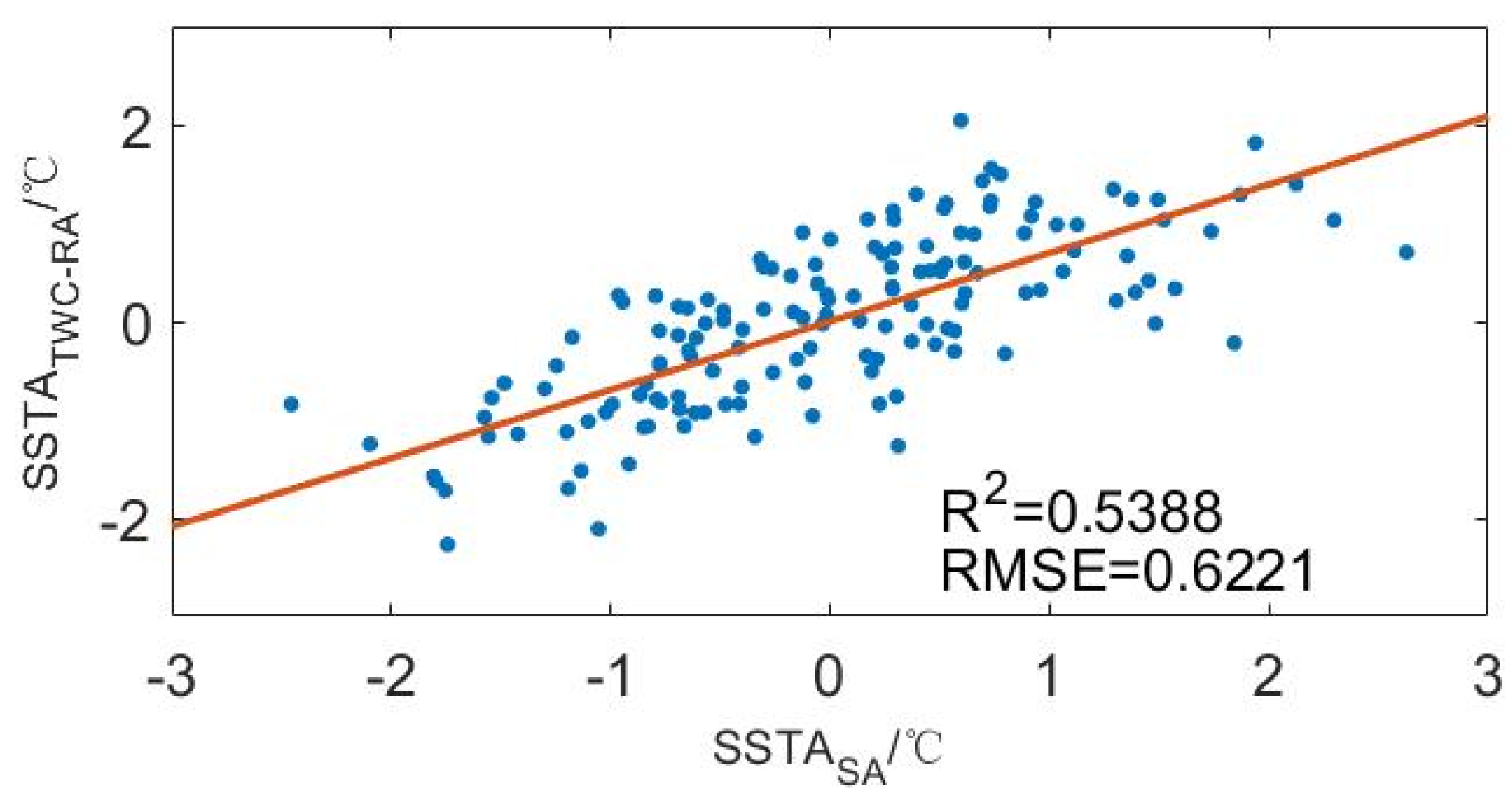
| Stage | Time/Month | Location |
|---|---|---|
| origin | April | sea area near Subei Shoal |
| development | mid-May | sea area near Yancheng of Jiangsu Province |
| bloom | June | Southern Yellow Sea |
| decline | July | Southern Yellow Sea |
| extinction | mid-August | along the southern coast of Shandong Peninsula |
| Data | Temporal Resolution | Spatial Resolution | Time Range/Year |
|---|---|---|---|
| Advanced Very High-Resolution Radiometer (AVHRR/3) | 1 day | 1.1 km | 2007~2019 |
| Cross-Calibrated Multi-Platform (CCMP) | 6 h | 28 km (0.25°) | 2007~2019 |
| Field data | 2010~2018 | ||
| Bulletin of China Marine Disaster | 2009~2019 |
Publisher’s Note: MDPI stays neutral with regard to jurisdictional claims in published maps and institutional affiliations. |
© 2021 by the authors. Licensee MDPI, Basel, Switzerland. This article is an open access article distributed under the terms and conditions of the Creative Commons Attribution (CC BY) license (https://creativecommons.org/licenses/by/4.0/).
Share and Cite
Pan, Y.; Ding, D.; Li, G.; Liu, X.; Liang, J.; Wang, X.; Liu, S.; Shi, J. Potential Temporal and Spatial Trends of Oceanographic Conditions with the Bloom of Ulva Prolifera in the West of the Southern Yellow Sea. Remote Sens. 2021, 13, 4406. https://doi.org/10.3390/rs13214406
Pan Y, Ding D, Li G, Liu X, Liang J, Wang X, Liu S, Shi J. Potential Temporal and Spatial Trends of Oceanographic Conditions with the Bloom of Ulva Prolifera in the West of the Southern Yellow Sea. Remote Sensing. 2021; 13(21):4406. https://doi.org/10.3390/rs13214406
Chicago/Turabian StylePan, Yufeng, Dong Ding, Guangxue Li, Xue Liu, Jun Liang, Xiangdong Wang, Shidong Liu, and Jinghao Shi. 2021. "Potential Temporal and Spatial Trends of Oceanographic Conditions with the Bloom of Ulva Prolifera in the West of the Southern Yellow Sea" Remote Sensing 13, no. 21: 4406. https://doi.org/10.3390/rs13214406
APA StylePan, Y., Ding, D., Li, G., Liu, X., Liang, J., Wang, X., Liu, S., & Shi, J. (2021). Potential Temporal and Spatial Trends of Oceanographic Conditions with the Bloom of Ulva Prolifera in the West of the Southern Yellow Sea. Remote Sensing, 13(21), 4406. https://doi.org/10.3390/rs13214406






